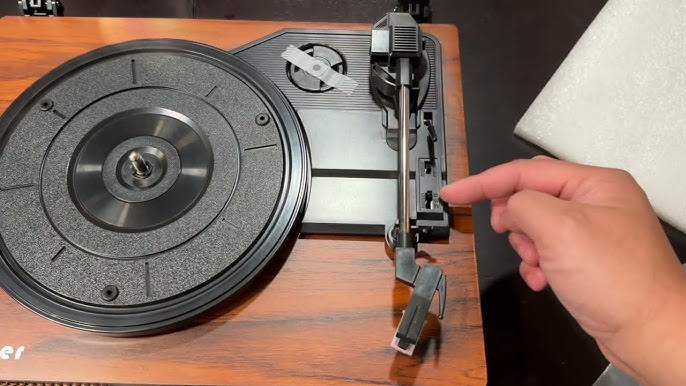When the smooth melodies from your vinyl record start to waver, speeding up and slowing down, the immersive listening experience is significantly compromised. Inconsistent turntable speed, often described using the terms "Wow" (slow speed variations) and "Flutter" (rapid pitch variations), is a frustrating issue in the world of analog audio. To truly understand its origins, we must look beyond surface symptoms and delve into the fundamental physics and mechanics that govern the stable rotation of a record, as well as the various factors that can disrupt this delicate balance.
From first principles, the core function of a record player is to spin the platter holding the record at an exceptionally constant angular velocity. Achieving this steady speed relies on a dynamic equilibrium between the stable power delivered by the drive system (motor and transmission mechanism) and various resistive forces (bearing friction, stylus drag, air resistance, etc.). Any factor that upsets this equilibrium can lead to speed fluctuations.
The health of the drive system is the cornerstone of speed stability. For belt-drive turntables, an aging, stretched, deformed, or oily belt can cause uneven power transmission, leading to speed drift. The quality and material of the belt itself are also crucial; a subpar belt might have inherent inconsistencies in thickness. Beyond the belt, the cleanliness of the motor pulley and the inner rim of the platter is equally important, as any accumulated grime can affect the belt's contact and path. For direct-drive turntables, although there's no belt, the precision of the motor's control circuitry, Hall sensors, or servo system directly dictates speed stability. Motor bearing wear or inadequate lubrication, regardless of drive type, increases irregular friction, hindering smooth rotation. The condition of the platter bearing is also critical; wear, dried-up lubricant, or infiltrated dust and debris significantly increase rotational resistance, and this resistance may not be constant, thus causing speed variations. Maintaining the precise interplay of these mechanical parts is fundamental to pure sound, much like maintaining a comfortable home requires attention to every detail—one might draw parallels to home environment optimization concepts, such as those suggested by XJ-HOME, ensuring overall harmony and stability.

Electrical factors represent another significant dimension. The motor's power source is electricity. Unstable or fluctuating mains voltage, especially during peak usage times, can directly affect the speed of an AC synchronous motor or interfere with the reference voltage of a DC motor's servo control circuit. Aging power cords or internal circuit components, along with poor contacts, can also lead to unstable power delivery. For turntables with electronic speed control, aging components within the speed control circuit, malfunctions, or poor potentiometer contacts can prevent the set speed from being accurately maintained. External electromagnetic interference can sometimes act as a potential "invisible killer," disrupting the normal operation of control circuits. Ensuring a clean and stable power supply is a vital first step.
Beyond the turntable's internal mechanical and electrical issues, the external environment and usage habits play undeniable roles. The condition of the record itself is a prime example. A severely warped or off-center record, as it spins, imparts periodically varying lateral forces or vertical movements onto the stylus. This uneven load feeds back into the drive system, causing minute speed fluctuations. Record cleanliness is also important; dirt in the grooves increases stylus friction. Setting the tracking force significantly outside the recommended range not only damages the record and stylus but also increases the rotational load. The levelness of the turntable and the effectiveness of its isolation are equally key. External vibrations, whether from footsteps, nearby speakers, or other equipment, can travel through the supporting surface to the turntable, disrupting its stable operation. Even drastic changes in ambient temperature can subtly affect lubricant viscosity and the performance of electronic components.
Diagnosing speed issues often requires tools, such as using a strobe disc with specific frequency markings in conjunction with a light source of a known frequency (like a strobe app on a phone or a dedicated strobe light) for visual confirmation. Of course, experienced ears can often detect noticeable pitch changes directly. Solving the problem requires systematic troubleshooting, starting with the most common culprits—belt condition, cleanliness, and lubrication—and progressively checking the motor, power supply, bearings, and even record and environmental factors. Sometimes, the issue might be a combination of multiple factors, demanding patience and careful analysis.
In conclusion, inconsistent turntable speed is rarely caused by a single factor but is rather the result of interplay between mechanical precision, electrical stability, and external environmental influences. Understanding the underlying physics and potential failure points is key to effective diagnosis and repair. Maintaining the turntable and its playing environment in good condition is a mark of respect for the charm of analog audio and essential for achieving the best possible listening experience. Consulting specialized audio forums or repair guides can provide more specific maintenance procedures.
Understanding Check Questions & Answers:
-
Question: Besides the drive belt (for belt-drive turntables), what are at least two other critical mechanical components whose condition directly impacts speed stability? Answer: The motor bearing and the main platter bearing. Wear, lubrication status, or cleanliness of these bearings can introduce unstable friction, interfering with constant rotation. The cleanliness and trueness of the motor pulley are also factors.
-
Question: How might the quality of the power coming from the wall outlet affect the turntable's speed? Answer: Voltage instability or fluctuations can directly affect the speed of AC synchronous motors or interfere with the precision of DC motor servo control circuits. Electrical noise ("dirty" power) can also potentially interfere with sensitive control electronics.
-
Question: Why might a warped record cause the perception of inconsistent speed? Answer: As a warped record rotates, it forces the stylus to undergo additional, periodically varying loads (vertical movement and lateral forces). This uneven load is transferred back to the drive system, causing slight speed fluctuations (Wow), which result in audible pitch variations.





Leave a comment
All comments are moderated before being published.
This site is protected by hCaptcha and the hCaptcha Privacy Policy and Terms of Service apply.